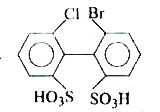Which of the following has an optical isomer?
[Co(en)(NH3)2]2+
[Co(H2O)4(en)]3+
[Co(en)2(NH3)2]3+
[Co(NH3)3Cl]+
The correct Answer is:C
To determine which of the given compounds has an optical isomer, we need to understand the concept of optical isomerism. Optical isomers, or enantiomers, are compounds that are non-superimposable mirror images of each other. This typically occurs in chiral molecules, which have at least one carbon atom bonded to four different substituents.
1. Identify the Compounds: We need to analyze the given options to identify which one might have an optical isomer. The options given are:
- Option 1: (COENNH3)
- Option 2: (C(EN)(H2O)3)
- Option 3: (T(EN)2(NH3)2)
- Option 4: (CO(NH3)3CN)
2. Analyze Option 1: The structure COENNH3 does not appear to have a chiral center as it does not have four different substituents attached to a carbon atom. Therefore, it does not have optical isomers.
Hint: Look for a carbon atom with four different groups attached to determine chirality.
3. Analyze Option 2: The structure C(EN)(H2O)3 also does not have a chiral center. The presence of three identical water molecules (H2O) means that it cannot form non-superimposable mirror images.
Hint: Identify identical groups attached to the central atom; identical groups indicate no chirality.
4. Analyze Option 3: The structure T(EN)2(NH3)2 has a central atom that is bonded to two different EN groups and two NH3 groups. If the EN groups are different, this can create a chiral center, allowing for the formation of optical isomers.
Hint: Check if the groups attached to the central atom are different; this can lead to chirality.
5. Analyze Option 4: The structure CO(NH3)3CN does not have a chiral center either, as it has three identical NH3 groups and does not meet the criteria for optical isomerism.
Hint: Again, look for identical groups; they prevent the formation of chiral centers.
6. Conclusion: Based on the analysis, Option 3 (T(EN)2(NH3)2) is the only compound that has a chiral center and can form optical isomers.
Final Answer:
Option 3 has an optical isomer.
- Option 1: (COENNH3)
- Option 2: (C(EN)(H2O)3)
- Option 3: (T(EN)2(NH3)2)
- Option 4: (CO(NH3)3CN)
Option 3 has an optical isomer.
Similar Questions
Knowledge Check
Which of the following will show optical isomerism?
A B
B C
C D
D
Which of the following will show optical isomerism?
View SolutionWhich of the following shows geometrical isomers ?
View SolutionWhich of the following pair are chain isomer?
View SolutionWhich of the following is an nuclear isomer of hydrogen ?
View SolutionWhich of the following is optically active?
View SolutionWhich of the following is optically active
View SolutionWhich of the following is not optically active?
View Solution